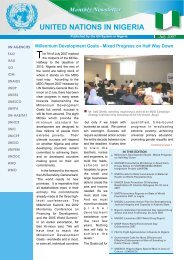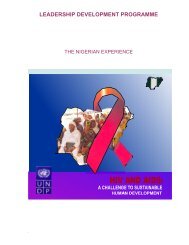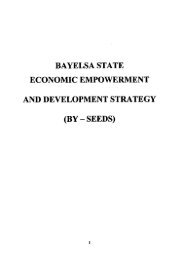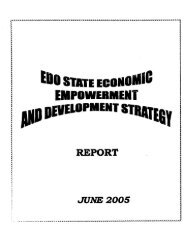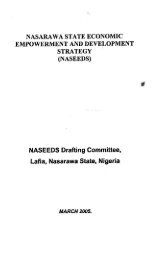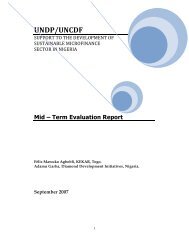Niger Delta Human Development Report - UNDP Nigeria - United ...
Niger Delta Human Development Report - UNDP Nigeria - United ...
Niger Delta Human Development Report - UNDP Nigeria - United ...
You also want an ePaper? Increase the reach of your titles
YUMPU automatically turns print PDFs into web optimized ePapers that Google loves.
urban and urban areas. Drawing from data<br />
from the National Bureau of Statistics<br />
(2005), the most widespread methods of<br />
waste or refuse disposal are disposal within<br />
household compounds (an average of 56.9<br />
per cent) and disposal in authorized heaps<br />
(34 per cent). Other methods are through<br />
collection by government (3.3 per cent),<br />
collection by private service providers (2.7<br />
per cent), the use of government disposal<br />
bins (1.4 per cent) and others (2.7 per cent).<br />
See also chart 1.7 for data on the<br />
distribution of household toilet facilities.<br />
Recent ecological studies have shown that<br />
the adverse consequences of waste<br />
generation and improper disposal have<br />
been severe on both people and the<br />
environment. These effects have also<br />
influenced the stagnation of human<br />
livelihoods and the region's economy. In<br />
increasing the misery and impoverishment<br />
of the populace, they have exacerbated<br />
political tension, acrimony, outright conflicts<br />
and violence.<br />
Education<br />
Statistical estimates have put the proportion<br />
of children attending primary school at 80<br />
per cent (which compares favourably with<br />
the estimated national average of 54 per<br />
cent). But across the region, nearly all<br />
school facilities are in a state of extreme<br />
disrepair, requiring major rehabilitation.<br />
The secondary school system has been<br />
seriously afflicted by shortages of quality<br />
teachers, a regional pattern that is becoming<br />
increasingly acute due in large part to<br />
discordance between investments in<br />
infrastructure outside a well-coordinated<br />
planning process.<br />
Revealing the immense challenge to<br />
development and provision of social<br />
amenities for sustainable livelihood, an<br />
NDES report (2000) noted that in the<br />
<strong>Niger</strong> <strong>Delta</strong> states, covering some 30,000<br />
square kilometres and with over 3,800<br />
settlements and an estimated eight million<br />
people, there were only 2,169 primary<br />
schools and 545 secondary schools. For<br />
primary schools, this implied one school per<br />
3,700 people serving an area of 14 square<br />
kilometres, and one school for every two<br />
settlements. For secondary schools, the ratio<br />
is one school per 14,679 people serving an<br />
area of 55 square kilometres, and one<br />
school for every seven settlements.<br />
Health and health service delivery<br />
Dismal health and health service delivery<br />
pitals, clinics and primary health centres;<br />
and a lack of effective operational plans<br />
for holistic health management. The<br />
majority of <strong>Niger</strong> <strong>Delta</strong> communities living<br />
in isolated areas lack the most basic<br />
modern medical care, including first aid,<br />
given the absence of formal health services<br />
in much of the hinterland (for the various<br />
dimensions of infrastructure and social<br />
services in the region, see the NDDC<br />
Regional Master Plan, 2003/2004, chapter<br />
one, pp. 1-19).<br />
The focus groups provided corroborative<br />
evidence on the status of health in the<br />
region, affirming that modern health care<br />
facilities are largely absent. The few existing<br />
public health care centers are all in critical<br />
need of repair. Villagers described them as<br />
moribund and offering little or no<br />
assistance. The centers lack doctors, nurses,<br />
and critical supplies such as drugs, syringes<br />
and sterilizers. There were a few privately<br />
run clinics, but focus group members said<br />
services there cost exorbitant amounts.<br />
Community members resort to local and<br />
traditional remedies to deal with their health<br />
conditions.<br />
According to the NDES (1997),<br />
communities have identified health as a<br />
major issue that must be addressed to<br />
improve their quality of life. In addition to<br />
a range of diseases such as malaria,<br />
gastroenteritis, respiratory track infections,<br />
measles, worm infestation, anaemia and<br />
heart diseases, malnutrition was seen as a<br />
major problem, especially among children,<br />
with about 10 per cent to 12 per cent<br />
severely malnourished, 18 per cent to 23<br />
per cent moderately so, and 30 per cent to<br />
40 per cent mildly malnourished. Fuelling<br />
this problem is a perceived lack of correct<br />
breastfeeding methods and household food<br />
insecurity.<br />
According to an NDES (2000) report on<br />
primary health care, there is a ratio of only<br />
one health care facility for every 9,805<br />
people, with the average facility serving an<br />
area of 44 square kilometres. There is one<br />
facility for approximately every 43<br />
settlements. The numbers worsen for<br />
secondary health care. There is only one<br />
facility for every 131,174 people, serving<br />
Dismal health and<br />
health care service<br />
delivery manifests in<br />
poor hygiene; little or no<br />
health information and<br />
education; a grossly<br />
inadequate capacity for<br />
service delivery;<br />
inadequate provision of<br />
hospitals, clinics and<br />
primary health centres;<br />
and a lack of effective<br />
operational plans for<br />
holistic health<br />
management.<br />
Nearly all school<br />
facilities are in a state of<br />
extreme disrepair,<br />
requiring major<br />
rehabilitation. The<br />
secondary school system<br />
in particular has been<br />
seriously afflicted by<br />
shortages of quality<br />
teachers.<br />
32 NIGER DELTA HUMAN DEVELOPMENT REPORT



